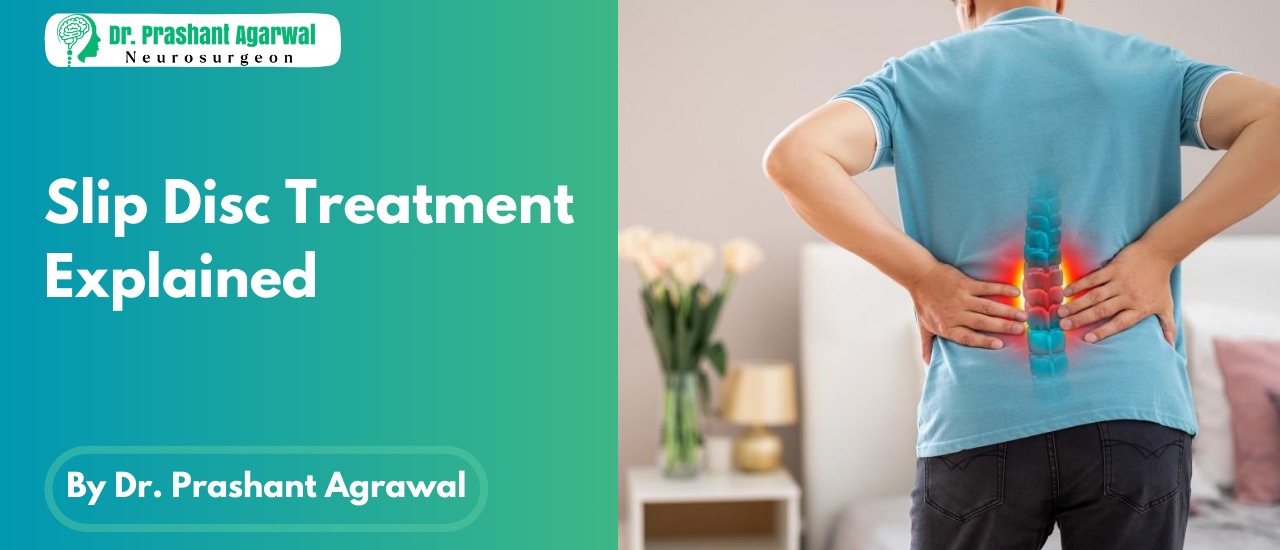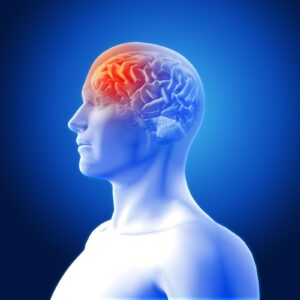Slip Disc Treatment Explained by – Dr. Prashant Agarwal
A slipped disc, also known as a herniated disc or disc prolapse, is a common issue that can cause significant discomfort, pain, and in some cases, long-term disability. The spine consists of vertebrae, which are separated by intervertebral discs, and these discs act as cushions, absorbing shock and preventing the vertebrae from rubbing against each other. However, when these discs shift out of place or rupture, they can press on nearby nerves, leading to pain, numbness, and tingling sensations. Dr. Prashant Agarwal, a renowned spine specialist, provides an in-depth look at the causes, symptoms, diagnosis, and treatment options for slip discs.
Understanding Slip Disc
A slip disc occurs when the soft inner core of an intervertebral disc (nucleus pulposus) pushes through the outer layer (annulus fibrosus). This can cause compression or irritation of the nerves that exit the spine, often leading to pain and discomfort in the back or legs.
There are several causes of slipped discs, with aging being one of the most common. As we age, the discs lose their flexibility and water content, making them more susceptible to damage. Other causes include poor posture, lifting heavy objects incorrectly, sudden twisting motions, obesity, and previous spinal injuries.
Symptoms of a Slip Disc
The symptoms of a slipped disc vary depending on the location of the herniation and whether or not the disc is pressing on nearby nerves. Common symptoms include:
– Back pain: A sharp, stabbing pain that often starts in the lower back and can radiate down the legs.
– Numbness or tingling: A sensation of numbness, tingling, or weakness in the affected area, particularly in the legs or arms.
– Sciatica: Pain that radiates from the lower back down through the buttocks and legs, often associated with a herniated disc in the lumbar region.
– Muscle weakness: A feeling of weakness in the muscles of the legs or arms, depending on which part of the spine is affected.
– Loss of bladder or bowel control: In rare cases, a slipped disc may lead to serious complications, including loss of bladder or bowel control. This requires immediate medical attention.
Dr. Prashant Agarwal emphasizes the importance of early diagnosis and treatment to avoid long-term complications.
Diagnosis of Slip Disc
Diagnosing a slipped disc involves a thorough physical examination and a review of medical history. Your doctor may ask about your symptoms, lifestyle, and any prior injuries that could contribute to the condition. They may also conduct tests to assess muscle strength, reflexes, and sensation in the affected area.
To confirm the diagnosis and determine the exact location of the herniated disc, imaging tests such as an MRI (Magnetic Resonance Imaging) or CT scan (Computed Tomography) may be required. These tests provide detailed images of the spine, helping the doctor identify the disc’s condition and any nerve involvement.
Treatment Options for Slip Disc
When it comes to treating a slipped disc, Dr. Prashant Agarwal takes a patient-centered approach, considering each patient’s unique circumstances. The goal of treatment is to relieve pain, restore function, and prevent further injury. There are several treatment options available, which can be divided into non-surgical and surgical methods.
- Non-Surgical Treatment
Most patients with a slipped disc will experience relief from non-surgical treatments. These treatments focus on alleviating pain, reducing inflammation, and improving mobility.
– Rest and Activity Modification: Resting in the initial days following the injury can help reduce inflammation. However, extended bed rest is not recommended. Dr. Agarwal advises patients to engage in light activity as soon as they can tolerate it to avoid stiffness and muscle weakening.
– Physical Therapy: A physical therapist can design a customized exercise program to strengthen the muscles surrounding the spine, improve posture, and increase flexibility. Physical therapy can also help alleviate pressure on the affected disc and improve overall spinal health.
– Medications: Over-the-counter pain relievers like ibuprofen or acetaminophen can help reduce pain and inflammation. In some cases, stronger medications such as muscle relaxants or steroids may be prescribed to control severe pain and inflammation.
– Hot or Cold Compresses: Applying heat or cold to the affected area can provide immediate relief. Cold compresses help reduce inflammation, while heat packs can relax tense muscles.
– Epidural Steroid Injections: For more severe pain, an epidural steroid injection may be administered directly into the area around the affected disc. This helps reduce inflammation and relieve pain, providing temporary relief while the patient continues physical therapy.
Dr. Agarwal highlights that the success of non-surgical treatments varies depending on the severity of the herniation. In many cases, non-invasive treatments can provide significant relief and allow the patient to return to their daily activities without the need for surgery.
- Surgical Treatment
While most people recover from a slipped disc with conservative treatments, some may require surgery if non-surgical options do not provide relief. Dr. Prashant Agarwal is highly experienced in performing minimally invasive spine surgeries, which offer several advantages over traditional open surgery.
– Microdiscectomy: This is one of the most common procedures for treating a slipped disc. It involves removing the portion of the herniated disc that is pressing on the nerve. The surgery is performed through a small incision, minimizing tissue damage and reducing recovery time. Most patients experience immediate relief from pain after the procedure.
– Laminectomy: In some cases, a laminectomy may be necessary. This procedure involves removing part of the vertebra (the lamina) to create more space around the affected disc and relieve pressure on the nerves.
– Spinal Fusion: In more severe cases, where multiple discs are damaged or the spine is unstable, spinal fusion may be recommended. This involves joining two or more vertebrae together to stabilize the spine. While effective in stabilizing the spine, spinal fusion requires a longer recovery time.
– Artificial Disc Replacement: In some cases, the damaged disc may be replaced with an artificial one. This is typically reserved for patients who have not responded to other treatments and for those who wish to preserve mobility in the spine.
Surgery is generally considered only when conservative treatments have failed, or if the patient experiences worsening symptoms, such as severe pain, muscle weakness, or loss of bladder control.
Preventing Slip Disc in the Future
Dr. Prashant Agarwal emphasizes that while some factors contributing to a slipped disc, such as age and genetics, cannot be controlled, many aspects of spinal health can be managed to prevent future occurrences. These preventive measures include:
– Maintaining a Healthy Weight: Being overweight increases the risk of spinal problems. Regular exercise and a balanced diet are crucial to maintaining a healthy weight.
– Proper Posture: Practicing good posture while sitting, standing, and lifting can reduce the strain on the spine. Dr. Agarwal recommends keeping your back straight, shoulders back, and knees slightly bent when lifting heavy objects.
– Regular Exercise: Strengthening the muscles of the back and abdomen provides additional support to the spine. Low-impact exercises, such as walking, swimming, and yoga, can improve flexibility and posture without putting undue stress on the spine.
Conclusion
A slipped disc is a condition that can be debilitating, but with the right treatment and preventive measures, most patients can recover and return to a normal, pain-free life. Dr. Prashant Agarwal’s holistic approach to treatment, which includes both non-surgical and surgical options, ensures that patients receive the care that best suits their needs. Whether through physical therapy, medications, or surgery, the goal is always to relieve pain, restore function, and improve the quality of life. By understanding the condition, seeking early intervention, and committing to long-term spinal health, individuals can reduce the likelihood of experiencing a slipped disc and enjoy a more active, pain-free lifestyle.





